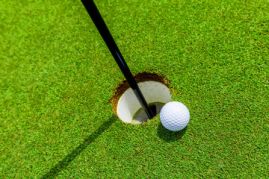January 26, 2023
No Question - Take the Pin Out!
 Last week's American Express PGA tournament in La Quinta, California should put to rest the discussion of whether to leave the pin in or out when putting. Davis Thompson was trailing Jon Rahm by one stroke as he putted on the 71st hole from 48 feet away. The putt was rolled beautifully and was tracking to the near center of the cup at a speed that, had the flagstick not been in, would have dropped for a birdie. However, the ball hit the pin in just the right way and bounced out. This unfortunate break cost him a chance at winning his first PGA Tour title. The flagstick should have been attended by his caddy, so the putt would have had every chance to go in.
Last week's American Express PGA tournament in La Quinta, California should put to rest the discussion of whether to leave the pin in or out when putting. Davis Thompson was trailing Jon Rahm by one stroke as he putted on the 71st hole from 48 feet away. The putt was rolled beautifully and was tracking to the near center of the cup at a speed that, had the flagstick not been in, would have dropped for a birdie. However, the ball hit the pin in just the right way and bounced out. This unfortunate break cost him a chance at winning his first PGA Tour title. The flagstick should have been attended by his caddy, so the putt would have had every chance to go in.
Scientific studies have shown that the flagstick is no advantage in 99,9% putts hit. That 0.1% advantage only comes on a putt that is hit way too hard and hits the pin preventing the ball from going well past the cup. If the pin were out in those cases, it would be going too fast to be holed. So why do some professionals continue to putt with the flagstick in, when they have statistical evidence that tell them it is a disadvantage? Bryson DeChambeau did it for a period of time, while Adam Scott and Matt Fitzpatrick are two of the better players to continue to putt with the pin in.
I believe Scott and Fitzpatrick know the risk of the flagstick causing a ball to pop out on a properly hit putt. But they believe the pin helps with their alignment and distance control. It may be a psychological thing, but they are willing to forego the small percentage of times the pin is a deterrent to their perception that it helps with aiming and distance judgement. The group I play with always leaves the pin in. It's easy and speeds the game up. Over the past three years, since the rule change, I personally have had at least 30 balls, or about 10 a year, that have hit the pin at the correct speed and not gone in. So it doesn't happen very often, but when I play in a tournament the pin definitely is out or attended on all putts. As yet I have not had an instance that the pin has helped me. I would think a professional golfer would not want to give up any strokes like this, because that means big money to them. In Davis Thompson's case, it was worth almost $600,000.
Scientifically the flagstick is no advantage, but conversely it is not a big disadvantage also. That infrequent occurrence that happened at The American Express is rare, but you still want to guard against it. Whenever I see someone putting in a professional tournament with the pin in, I'm afraid the pin will knock it out. You usually don't think it will happen from long distances, but obviously it can and did happen. I think everyone on all professional tours took note and you will see more caddies attending the flagstick for long putts in the future.



